Forget what you think you know about cement – that boring gray building material is about to become your new favorite DIY medium.
When transformed by your own hands, cement can create stunning, high-end looking decor that rivals expensive designer pieces – at a fraction of the cost.
Let’s look at top cement projects that are surprisingly simple to make but look impressively professional.
✨Click to Get My 101 FREE Designer Room Ideas
Sleek Concrete Countertops That Rival Stone
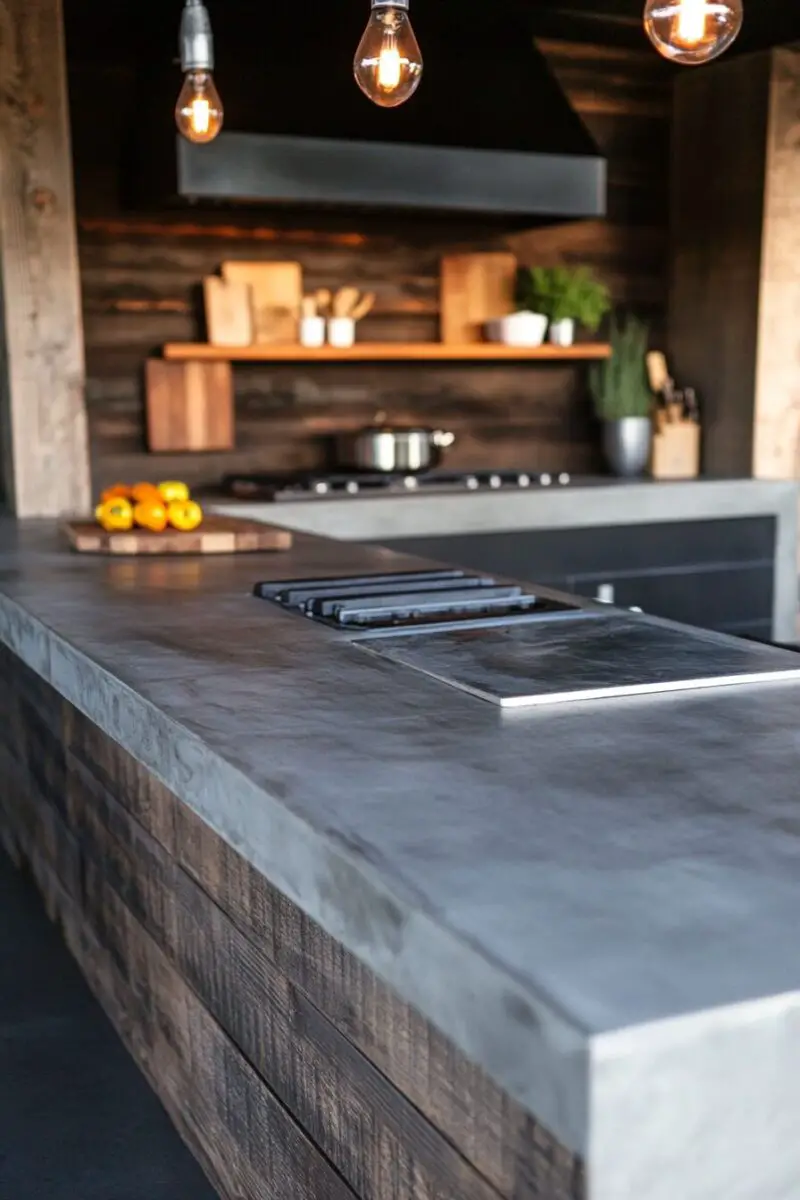
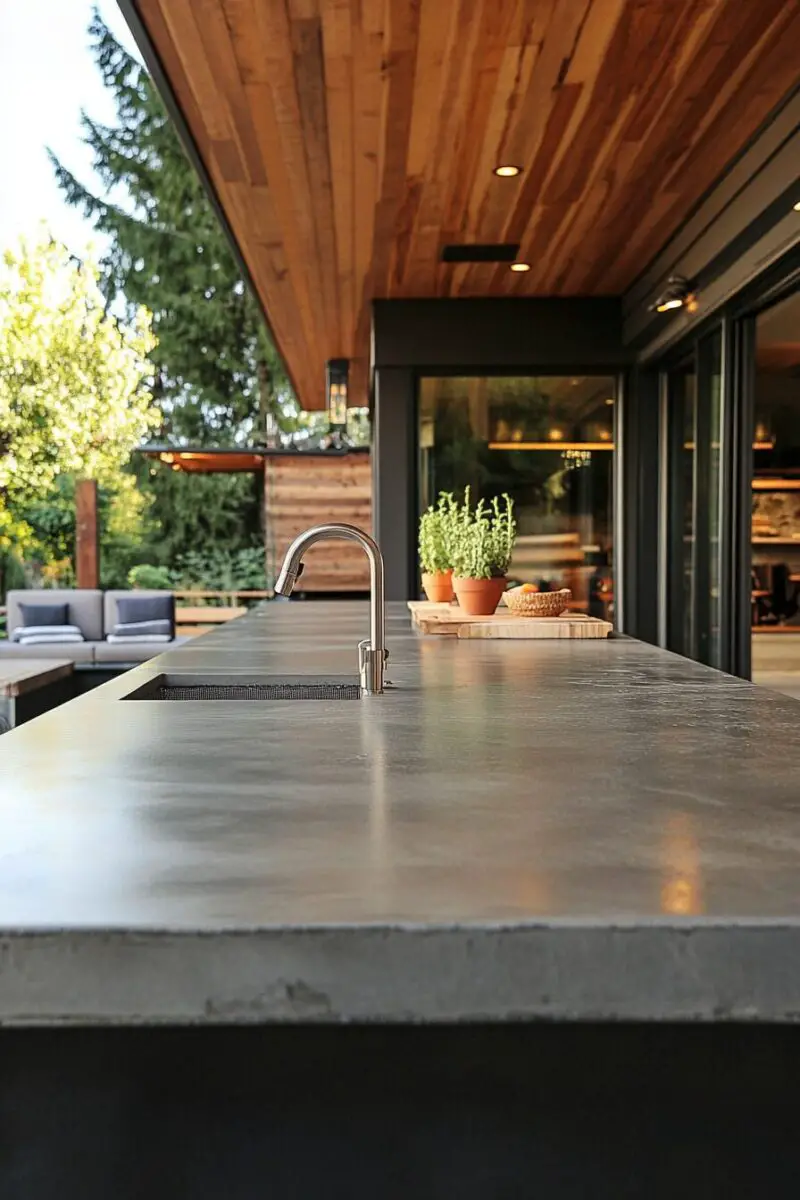
Imagine running your hands across a smooth, cool surface that looks like it belongs in a luxury penthouse – but you made it yourself for pennies on the dollar.
Concrete countertops have taken the design world by storm, offering the perfect mix of industrial chic and timeless elegance.
To create your own, you’ll need melamine boards to build a mold of your counter dimensions, reinforcing wire mesh, concrete mix, and concrete sealer.
The beauty of DIY concrete countertops lies in the customization – you can embed decorative elements like glass pieces, add pigments for unique colors, or polish to different finishes from matte to high gloss.
With concrete, you can create seamless, integrated features like built-in drainboards, trivets, or even embedding wireless charging stations beneath the surface.
The process involves building your mold, mixing and pouring concrete, vibrating to remove air bubbles, curing properly, and finally finishing with a food-safe sealer.
Even beginners can achieve professional results by taking their time and following detailed instructions – with the most complex part being proper reinforcement and preventing cracks.
Your friends will never believe you made these countertops yourself – they’ll assume you spent thousands on custom stonework when you might have invested just a few hundred dollars in materials.
The end result is incredibly durable, heat-resistant, and uniquely yours – something no factory-made counter can claim.
With proper sealing, your DIY concrete countertops will last for decades, developing a beautiful patina over time that adds character rather than looking worn.
Statement Cement Planters That Look Designer-Made


Picture this: stunning geometric planters with clean lines and perfect proportions adorning your space – the kind that cost $100+ in boutique stores but you crafted for under $20.
Creating cement planters allows you to play with shapes and sizes that perfectly complement your specific plants and décor style.
The basic process involves creating nested molds (think plastic containers, milk cartons, or custom forms) with the outer mold being the shape of your planter and the inner creating the hollow cavity.
What makes these planters special is the ability to add striking visual elements – marble effects with acrylic paint, embedded mosaic pieces, or even glow-in-the-dark aggregates that create magical evening displays.
You can create drainage channels during the molding process, ensuring your plants thrive while maintaining the planter’s sleek appearance.
Advanced techniques include creating ultra-lightweight planters by adding perlite to your concrete mix or making self-watering versions with hidden reservoirs.
The concrete naturally develops beautiful variations in color and texture, meaning no two planters will ever look exactly alike – perfect for creating an organic, collected-over-time aesthetic.
For outdoor use, adding fiber reinforcement to your cement mix creates planters that withstand freezing temperatures without cracking – something many store-bought planters can’t claim.
With simple tools and materials from any hardware store, you’ll be amazed at how quickly you can create an entire collection of coordinated planters that would cost hundreds retail.
The natural alkalinity of cement even helps neutralize soil acidity over time, making these planters not just beautiful but beneficial for certain plant varieties.
Mesmerizing Concrete Stepping Stones That Transform Your Garden
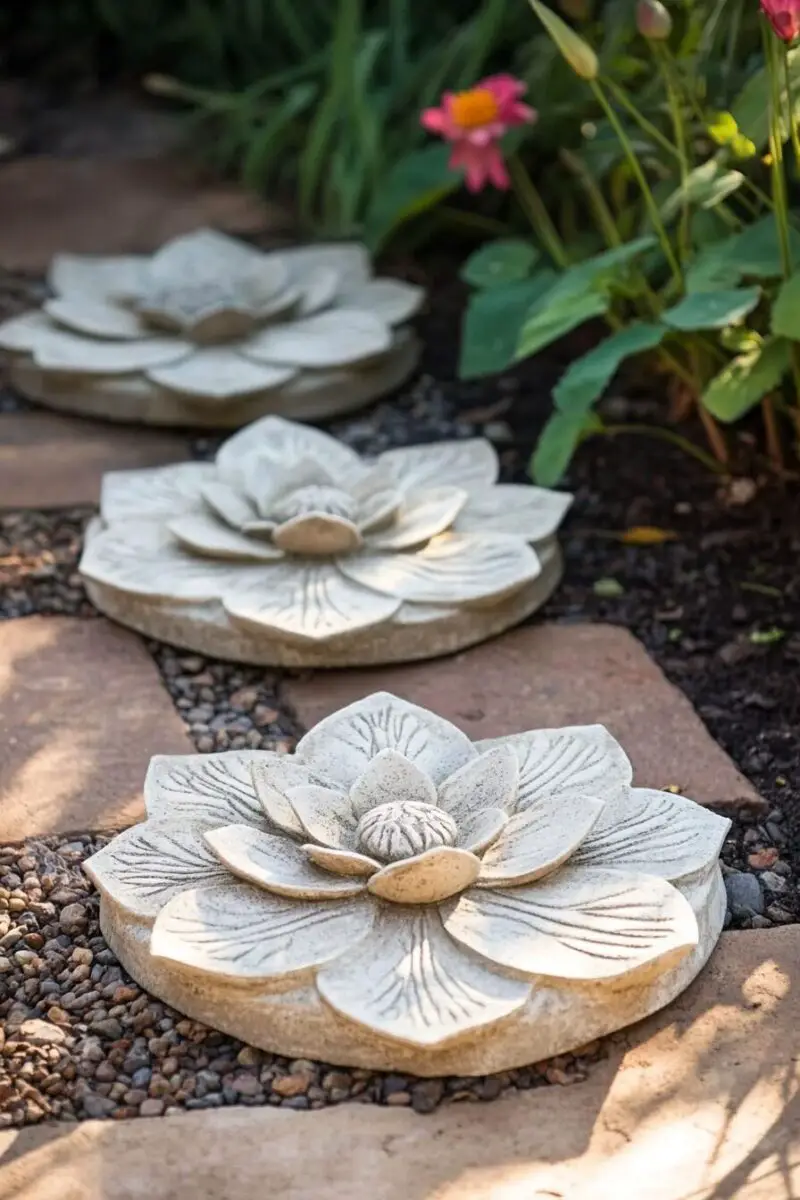
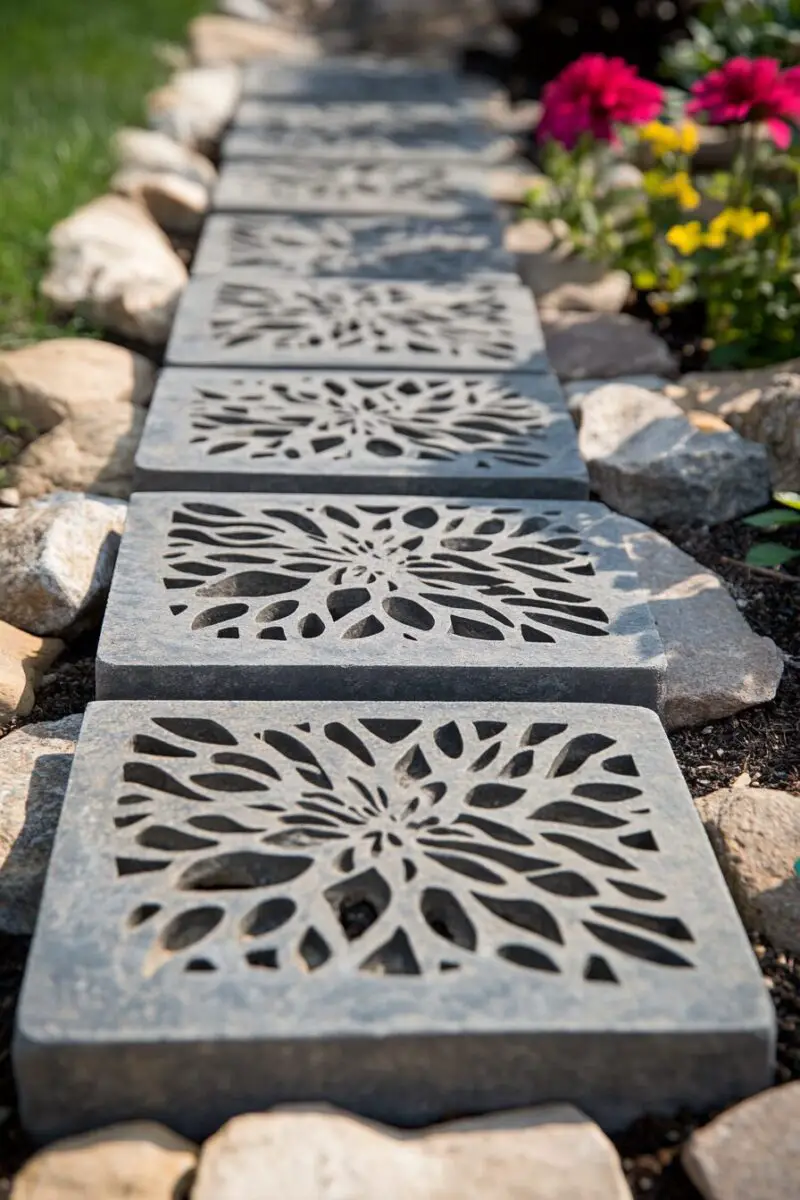
Imagine walking through your garden on unique stepping stones that look like they were imported from an exclusive landscape design showroom – each one a personal work of art.
Creating concrete stepping stones allows you to establish pathways that perfectly complement your garden’s style – whether sleek and modern or whimsical and colorful.
The basic process uses simple cake pans, plastic molds, or even large leaves as the base form, then allows for endless customization through stamping, embedding objects, or adding colored glass.
What makes these stepping stones extraordinary is how they weather beautifully over time – moss growing in the crevices, colors mellowing, creating that coveted “been-there-forever” garden charm that can’t be purchased.
You can incorporate personal elements like hand prints, children’s artwork transferred to the surface, or meaningful words stamped into the wet cement.
Advanced techniques include creating glow-in-the-dark pathways using phosphorescent crystals mixed into certain sections of your stepping stones – creating magical nighttime garden experiences.
The concrete naturally absorbs and releases heat throughout the day, making your pathway surprisingly comfortable underfoot even on hot summer days or cool evenings.
For winter gardens, embedding heating wires into larger stepping stones creates snow-melting pathways that remain clear and safe during freezing weather.
With simple materials and basic tools, you can create dozens of unique stepping stones in a weekend, transforming your entire garden landscape for less than the cost of a single designer stone.
The versatility allows you to match any garden theme – from Japanese-inspired circular patterns to Mediterranean mosaic styles to ultramodern geometric designs.
Stunning Concrete Pendant Lights That Illuminate With Style


Imagine the conversation starter hanging above your dining table – a sculptural light fixture with the perfect balance of industrial edge and elegant form that everyone assumes came from a high-end lighting studio.
Concrete pendant lights have become design staples in upscale restaurants and boutique hotels, but you can create your own statement piece for less than $50.
The process involves creating a mold (often using plastic containers or custom forms), embedding light fixtures and wiring channels, then casting ultra-thin concrete that allows light to filter through in fascinating ways.
What makes these lights extraordinary is how the density of the concrete creates a warm, diffused glow that flatters everything in the room – no harsh shadows or unflattering bright spots.
You can embed colored glass pieces or metal flakes into the concrete that sparkle when illuminated, creating dramatic visual effects that change depending on the viewing angle.
Advanced techniques include creating concrete mixtures with translucent properties or embedding fiber optics within the concrete itself for star-like points of light across the surface.
The natural cooling properties of concrete help dissipate heat from the bulb, making these fixtures safer for long-term use than many plastic or resin alternatives.
With proper internal reinforcement using mesh or fibers, these pendants remain incredibly lightweight while appearing substantially more massive – creating visual impact without requiring special ceiling supports.
The variations in each handmade fixture ensure you’ll have a truly one-of-a-kind lighting solution that cannot be exactly duplicated – the hallmark of true luxury design.
With careful crafting and simple LED components, these fixtures can last for decades, becoming heirloom pieces that tell the story of your creativity and craftsmanship.
✨Click to Get My 101 FREE Designer Room Ideas
Eye-Catching Concrete Bookends That Showcase Your Style

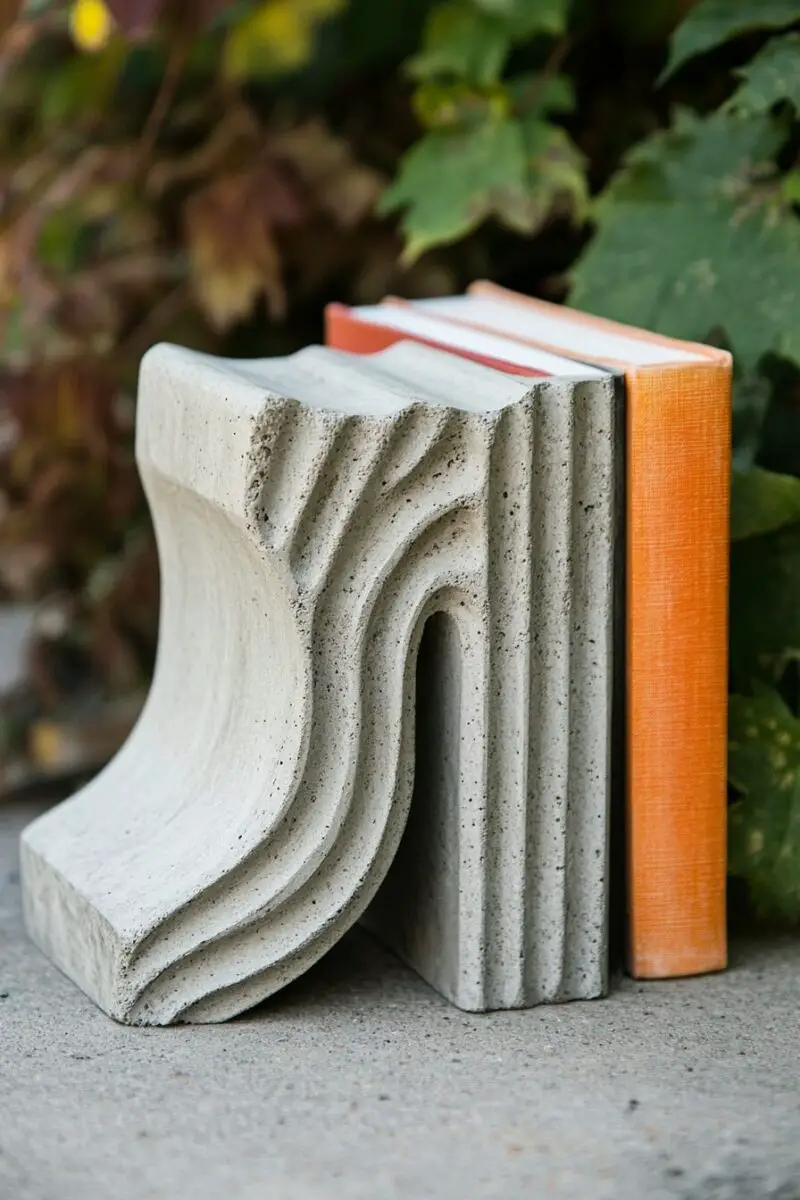
Picture perfect pairs of bookends that look like they came from a high-end design catalog but were created by your own hands for a fraction of the retail price.
Creating concrete bookends allows you to express your personal style – from minimalist geometric shapes to detailed sculptural pieces that complement your book collection.
The basic process uses simple silicone molds or custom forms created from cardboard and plastic, with the option to embed decorative elements like geodes, metal accents, or colored resin inlays.
What makes these bookends special is their perfect combination of form and function – the natural weight of concrete makes them incredibly effective at supporting books while serving as standalone art pieces.
You can incorporate technology like embedded LED lights, hidden compartments for small valuables, or even wireless charging capabilities into more advanced designs.
Advanced techniques include creating marbled effects with different colored concrete pours, embedding metal leaf for metallic accents, or creating reversible bookends with different designs on each side for seasonal changes.
The contrast between rough industrial concrete and precious materials like gold leaf or polished stone creates bookends with visual tension that elevates your entire bookshelf display.
For practical durability, adding felt pads to the bottom prevents scratching furniture surfaces while giving your handmade creations a professional finished look.
With basic materials and simple tools, you can create pairs of designer-quality bookends that would retail for $75-200 in specialty shops for less than $15 in materials.
The creative possibilities are endless – from literary-themed designs that reference your favorite books to abstract sculptural forms that complement your overall decor style.
Impressive Concrete Fire Pit That Becomes Your Yard’s Focal Point

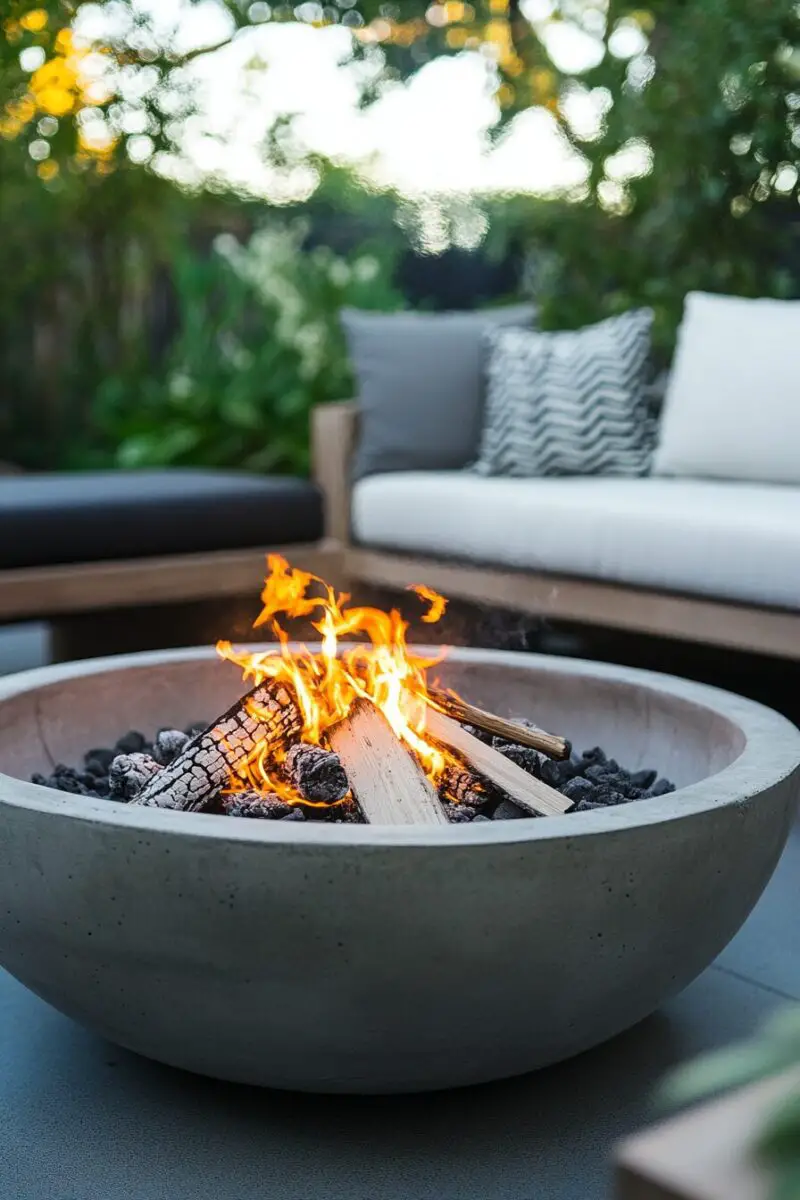
Imagine hosting friends around a perfectly designed fire pit that looks like it was installed by professional landscapers – but you built it yourself for a quarter of the price.
Creating a concrete fire pit transforms your outdoor space into an entertainment destination that can be used year-round for gatherings, cooking, or simply enjoying quiet evenings outside.
The basic process involves creating circular forms (often using flexible materials like bender board), pouring a concrete base and outer ring, then finishing with heat-resistant inner materials and decorative elements.
What makes a DIY concrete fire pit special is the ability to customize every detail – from the exact height and diameter that fits your space to integrated seating, wood storage, or cooking attachments.
You can incorporate stunning visual elements like colored glass aggregate that sparkles in the firelight, embedded LED lighting for ambiance when the fire isn’t lit, or custom designs stamped into the concrete surface.
Advanced techniques include creating dual-purpose fire pits with removable covers that convert to tables, integrated water features for dramatic fire-and-water displays, or built-in cooking surfaces for outdoor meals.
The thermal mass of concrete actually enhances your fire pit experience by absorbing heat during use and radiating it slowly throughout the evening – keeping the area comfortable even as outside temperatures drop.
For all-season enjoyment, creative designs can include hidden propane connections for instant flames without wood preparation, adjustable air flow controls for perfect burning, or protective covers that integrate seamlessly with the design.
With careful planning and basic materials, you can create a fire pit that becomes the heart of your outdoor living space while increasing your property value – all for a weekend’s work and a few hundred dollars.
The creative control means your fire pit can perfectly match architectural elements of your home, creating a cohesive outdoor environment that looks professionally designed and built.
Artistic Concrete Wall Art That Makes a Bold Statement
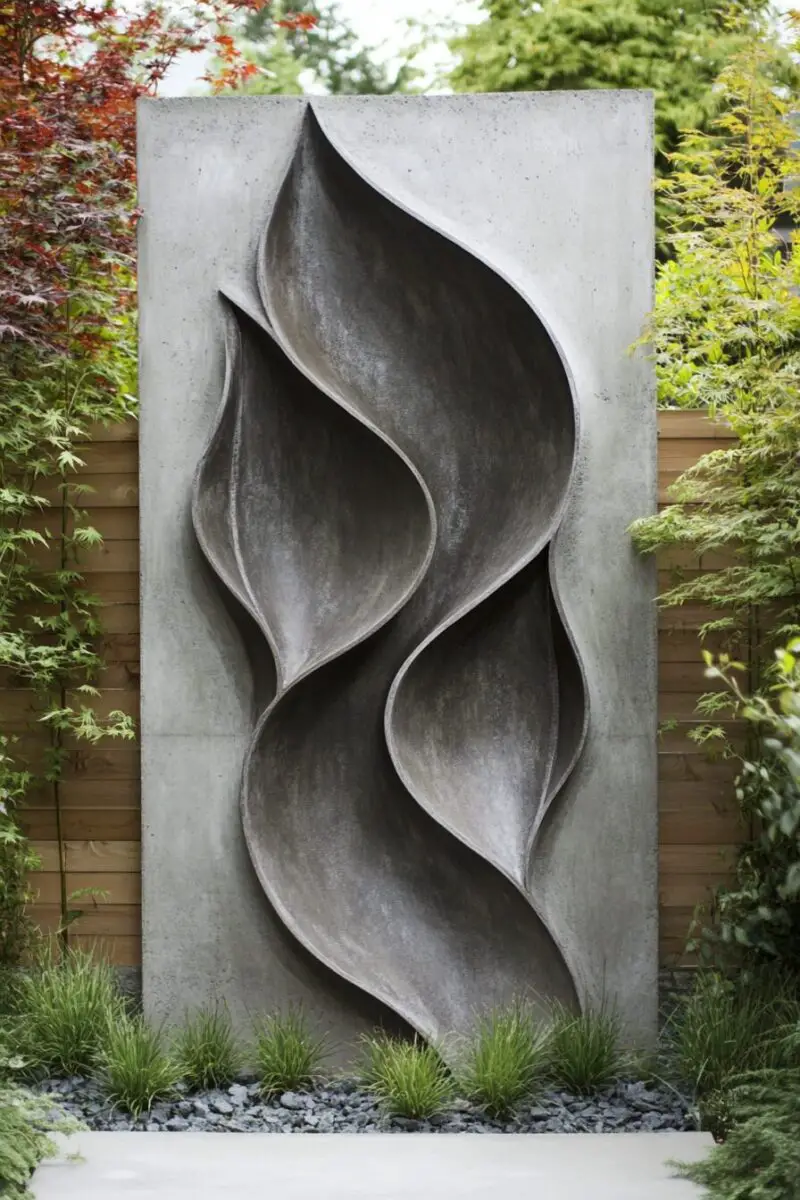
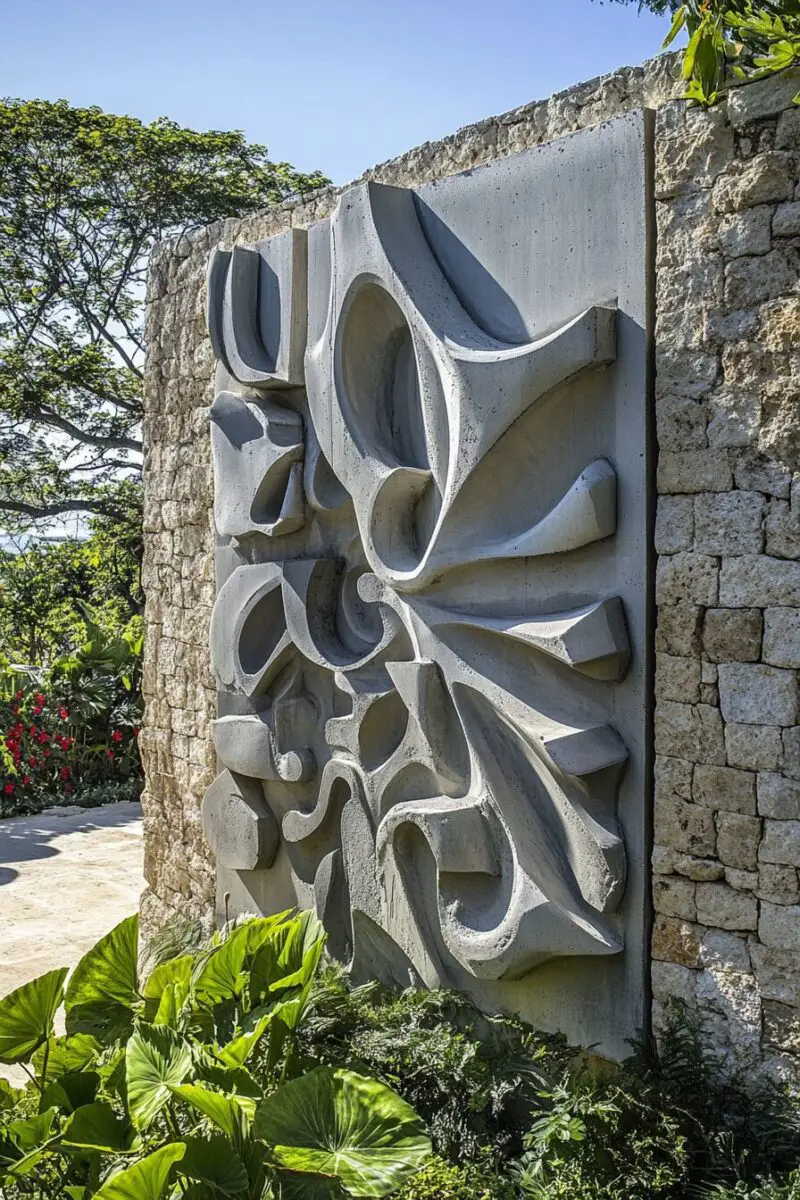
Imagine the conversation piece hanging in your living room – a sculptural wall installation with perfect texture and composition that everyone assumes came from an upscale gallery.
Creating concrete wall art allows you to explore the medium’s unique properties – its ability to capture intricate textures, its metamorphosis from liquid to solid, and its surprisingly lightweight potential when properly mixed.
The basic process involves creating custom molds from foam, wood, or silicone, reinforcing with fiberglass mesh, and exploring specialized concrete mixes that allow for thin, detailed castings that won’t overwhelm standard walls.
What makes concrete wall art extraordinary is the unexpected juxtaposition of industrial material with fine art sensibilities – creating pieces with depth, shadow play, and tactile qualities that flat paintings simply can’t achieve.
You can incorporate contrasting elements like wood inlays, metal accents, colored epoxy “rivers,” or LED backlighting that transforms the piece completely when illuminated at night.
Advanced techniques include creating multi-panel installations that align perfectly to form larger images, embedding photographic transfers into the concrete surface, or creating concrete canvases for mixed media applications.
The natural variations in each concrete pour ensure every piece is genuinely unique – with subtle color shifts, tiny air pockets, and mineralization patterns that develop character over time like fine marble.
For practical installation, creating integrated hanging systems during the casting process ensures secure mounting while maintaining the clean lines of your finished piece.
With simple tools and specialized concrete mixes designed for art applications, you can create gallery-quality wall installations that would sell for thousands in design showrooms for less than $100 in materials.
The versatility of concrete as an artistic medium allows for everything from hyperrealistic botanical impressions to geometric abstractions to architectural relief maps – all with a sophisticated modern aesthetic that elevates your entire space.
Modern Concrete Furniture That Redefines Your Space
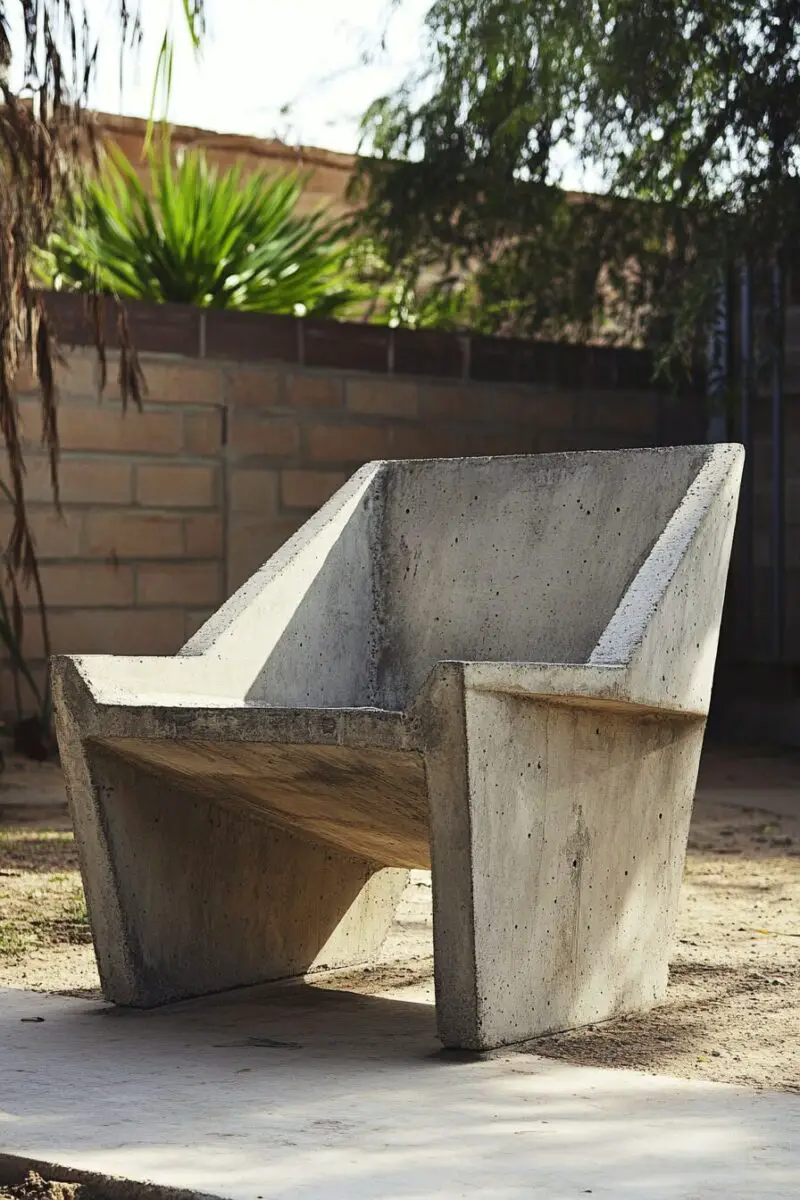
Picture the perfect side table – architectural, sculptural, impossibly cool – the kind design magazines feature and boutiques sell for hundreds of dollars, now sitting in your living room because you created it yourself.
Crafting concrete furniture opens a world of design possibilities that store-bought pieces simply can’t match – custom dimensions, integrated features, and one-of-a-kind forms that perfectly suit your specific space.
The basic process involves building sturdy molds from melamine or sealed wood, reinforcing with rebar or mesh, and pouring special lightweight concrete mixes designed specifically for furniture applications.
What makes concrete furniture special is its chameleon-like ability to complement any design style – from sleek minimalist cubes that work in ultramodern spaces to organic, flowing forms that soften contemporary rooms.
You can incorporate practical elements like built-in USB charging ports, hidden storage compartments, integrated planters, or even LED lighting systems that transform functional pieces into atmospheric light sculptures.
Advanced techniques include creating “floating” designs with hidden supports, combining concrete with contrasting materials like wood or metal for visual interest, or embedding heating elements in outdoor furniture for year-round comfort.
The thermal properties of concrete furniture actually work in your favor – side tables that won’t be damaged by hot cups, outdoor benches that warm gradually in the sun without becoming too hot, and pieces that maintain stable temperatures despite environmental fluctuations.
For practical usability, applying specialized concrete sealers creates surfaces that resist staining and water damage while enhancing the natural beauty of the material with matte, satin, or high-gloss finishes.
With basic tools and materials costing under $100, you can create designer-quality furniture pieces that would retail for $500-1500, customized perfectly to your color scheme, dimensions, and functional needs.
The substantial nature of concrete creates furniture with presence – pieces that anchor a room, create visual weight, and convey quality in a way that mass-produced lightweight furniture simply cannot achieve.
✨Click to Get My 101 FREE Designer Room Ideas
Luxurious Concrete Bathroom Sink That Transforms Your Morning Routine
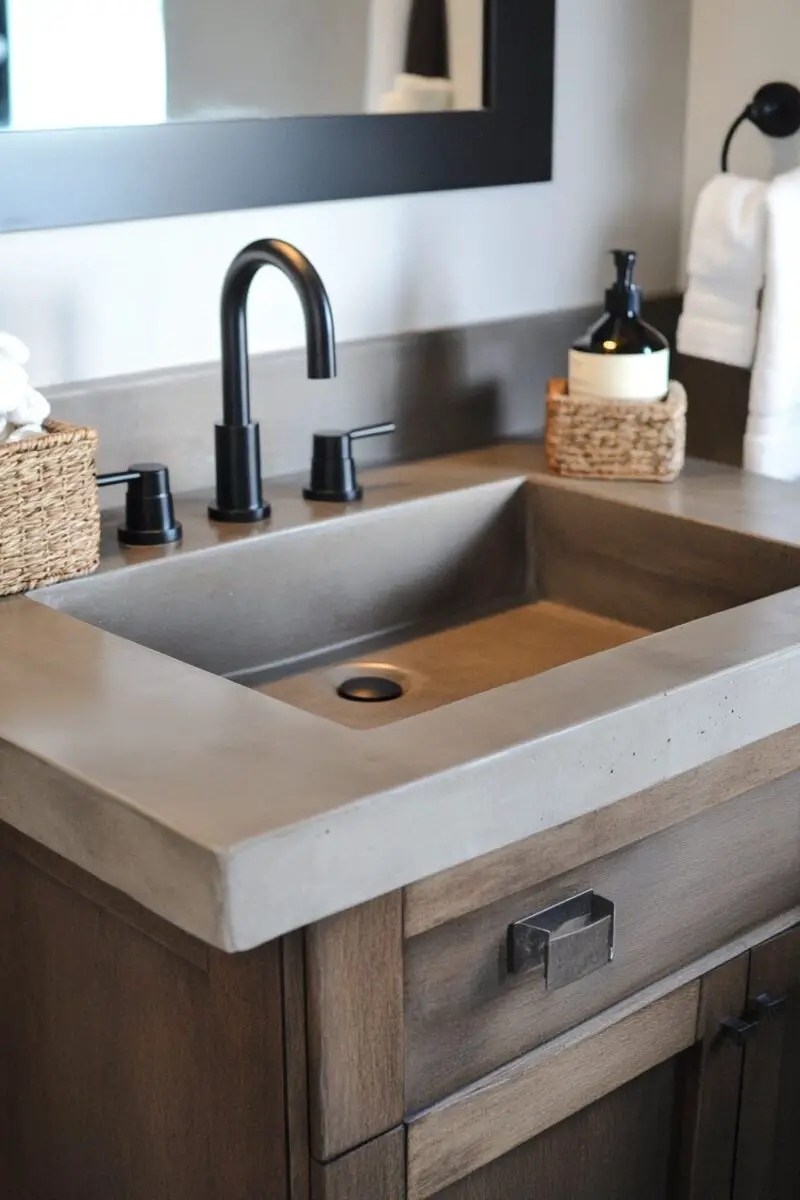
Imagine starting each day at a sink that looks like it belongs in a boutique hotel – a perfectly proportioned basin with sleek lines or organic curves that perfectly suits your bathroom’s style.
Creating a concrete bathroom sink allows for complete creative control – from the exact dimensions that fit your space to integrated features like soap dishes, backsplashes, or even dual basins custom-sized for your needs.
The basic process involves building a two-part mold (for the exterior shape and interior basin), reinforcing with fiberglass mesh, and using specialized concrete mixes designed for water resistance and fine detail.
What makes a DIY concrete sink extraordinary is the ability to integrate it perfectly with your existing space – matching the exact width of your vanity, creating a custom color that complements your tiles, or designing an irregular shape for challenging corner installations.
You can incorporate stunning visual elements like embedded river rocks, colored glass aggregates, glow-in-the-dark inlays for nighttime use, or fossilized materials that create one-of-a-kind natural patterns.
Advanced techniques include creating integrated drainboards that slope perfectly to the basin, seamless backsplashes that eliminate grimy seams, or even built-in UV sterilization channels for toothbrushes.
The thermal properties of concrete create a unique user experience – a sink that doesn’t immediately feel ice-cold in winter mornings and that helps cool water maintain its temperature longer during summer months.
For practical durability, applying specialized concrete sealers designed specifically for constant water exposure ensures your sink remains beautiful for decades without water staining or bacterial growth.
With careful preparation and materials costing $100-200, you can create a designer-quality sink that would retail for $1,000-3,000, perfectly customized to your exact specifications and design vision.
The substantial nature of a concrete sink anchors your bathroom design with a centerpiece that feels permanent and significant – elevating the entire room from basic to bespoke with a single weekend project.
Striking Concrete Tiles That Create Show-Stopping Floors and Walls
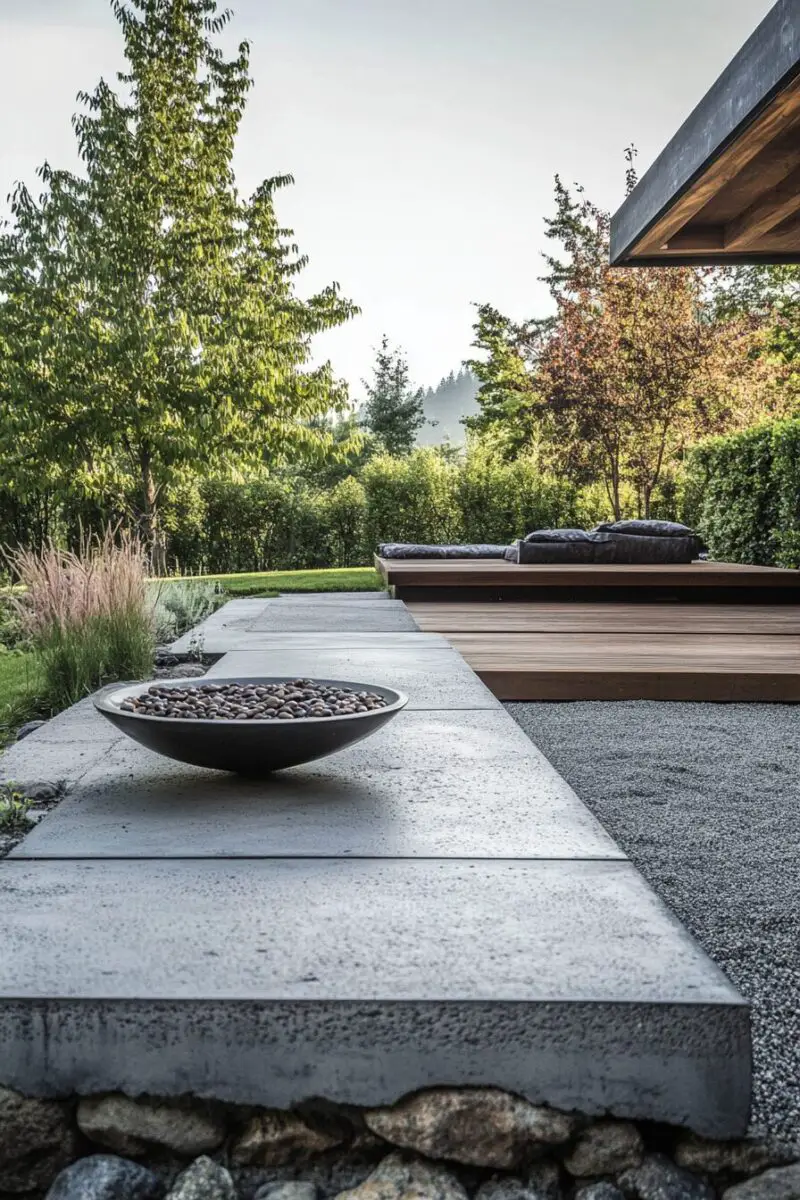

Imagine walking on floors that look like they were imported from a Mediterranean villa or historic Moroccan riad – intricate patterns, subtle color variations, and perfect patina that gets better with age.
Creating concrete tiles allows you to design completely custom patterns, colors, and sizes that cannot be found in store-bought options – giving your space truly one-of-a-kind surfaces.
The basic process involves creating rubber molds (either purchased or handmade), mixing specialized fine-grained concrete with colorants, and carefully curing each tile to prevent cracking and ensure durability.
What makes DIY concrete tiles extraordinary is the unlimited design potential – from replicating historic patterns to creating contemporary geometric designs to developing completely original artistic expressions that become your signature style.
You can incorporate special effects like marbling between colors, embedding small objects like shells or glass, or creating three-dimensional relief patterns that catch light and shadow throughout the day.
Advanced techniques include creating encaustic-style tiles with multiple colored layers, developing specialized textures for slip-resistance in wet areas, or embedding heating elements for luxurious warm floors in bathrooms and entryways.
The natural aging process of concrete tiles creates a beautiful patina over time that mass-produced ceramic tiles can never achieve – slight variations in wear pattern and mineralization that add character rather than looking damaged.
For practical installation, creating precisely-sized tiles with consistent thickness allows for professional-looking results even for DIY installers, while specialized sealers ensure longevity in high-traffic or moisture-prone areas.
With simple materials and techniques, you can produce custom tiles for $3-5 per square foot that would cost $20-30 per square foot from specialty manufacturers, transforming entire rooms for the price of a small store-bought installation.
The design flexibility means your floors or backsplashes can perfectly complement your overall design concept – whether creating seamless visual flow throughout your space or establishing dramatic focal points that define separate zones.
Who knew that humble cement could transform into so many stunning home features?
The best part isn’t just the money saved – it’s the pride and satisfaction of pointing to your favorite home features and saying, “I made that myself.”


